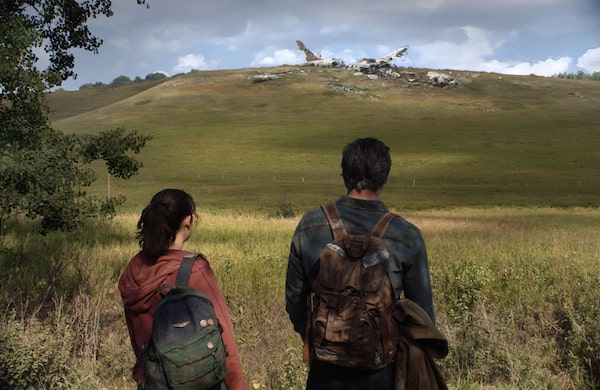
The Last of Us takes place 20 years after modern civilization has been destroyed. Joel (Pedro Pascal), a hardened survivor, is hired to smuggle Ellie (Bella Ramsey), a 14-year-old girl, out of an oppressive quarantine zone.HBO / Crave
Alberta could use some fun. And it turns out that an HBO show about a post-apocalyptic world ravaged by a mass fungal infection is just the ticket.
The Last of Us, filmed in the province in 2021 and 2022, is a certified hit. After premiering last month, it’s in the rarefied realm of averaging more than 15 million views per episode – and it’s already been renewed for a second season.
It cost somewhere north of $10-million per episode, with The New Yorker reporting that HBO gave the series a budget exceeding that of each of the first five seasons of Game of Thrones. Luke Azevedo, the film commissioner at Calgary Economic Development, said The Last of Us is by far the largest film or TV project ever filmed in Alberta – and possibly in Canada.
We knew it was going to be big, but I don’t know if anybody expected it to be this good. Even if you don’t like zombie-like tales or the idea of a series adapted from a video game, Episode 3 is a masterpiece. Spoiler alert: Most of it focuses on an unexpectedly tender, middle-aged love story that provides respite from constant danger.
“The amount of viewership that it’s getting on a global scale, and the reaction that people are having to the actual content – it’s unprecedented for us, and probably most productions ever made,” Mr. Azevedo said. “It has changed the perception of our industry, knowing we can do a production of this size and scope.”
When outsiders think about Alberta, they often picture cowboys, oil and fraught federal-provincial relations. Sure, the province is all of those things. But a film and TV industry, now bolstered by the success of The Last of Us, gives Alberta a chance to show it’s more.
The series is also a clear indication that an economic-diversification push by NDP and UCP governments – especially the decision under premier Jason Kenney to make production tax breaks more generous the year it started filming – means a new industry has become entrenched.
“We don’t have to be reliant on one, two or three sectors. We can actually have a broad base of talent that can actually be employed in different ways,” Calgary Mayor Jyoti Gondek said. “We continue to be committed to chase Season 2.”
In The Last of Us, a Cordyceps mutation spreads rapidly in 2003 and turns most of Earth’s population into spore-spreading ghouls. Twenty years later, everyone has some kind of tragic backstory, but the narrative focuses on a military-trained smuggler and an exceptional 14-year-old girl’s odyssey across infected America.
Even if this journey from Boston makes the show somewhat reminiscent of a Western, the show isn’t west-specific. Productions filmed in Alberta often rely on the scenic backdrop, including the Fargo series; the new Predator franchise instalment, Prey; and going further back, Unforgiven, Legends of the Fall and Brokeback Mountain. In contrast, in the first episodes of The Last of Us, the province stands in for Texas, and, far less intuitively, Jakarta and Massachusetts.
But that won’t take away from Albertans relishing the fun of seeing their cities and parks in such a big show. Downtown Calgary plays Boston. The legislature in Edmonton is a stand-in for the Massachusetts State House. And High River was home to most of the filming for the latest episode.
“It’s so great for the community. It just livens it up,” Hayley Kerr at the Museum of the Highwood in High River said of the crews that took over the town south of Calgary in the depths of the COVID-19 pandemic.
Now, she and other staff at the museum and visitor centre are preparing for an influx of global The Last of Us fans, similar to what happened when the popular series, Heartland, was added to Netflix.
The main filming site in High River was the old Beachwood Estates neighbourhood – badly damaged in Alberta’s 2013 floods. Given the likelihood of future floods, the area’s houses were removed, and the land is returning to a more-natural state. But as the filming of The Last of Us took place, the perfect overgrown roads were still in place. And crews built a small U.S. East Coast town on the site, including the home of key side characters Bill and Frank – the best part of the series so far.
Comedian and actor Nick Offerman, who plays Bill, originally had a scheduling conflict that would have prevented him from being in the show. But then his wife, fellow performer Megan Mullally, read the screenplay, according to Vulture: “Buddy, you’re going to Calgary,” she told him.
Even in the love and human survival story, there’s an injection of the political themes of which Alberta is often in the middle. The first moments of the series hint that climate change might have made the world more susceptible to the malignant fungal spread. In the seminal Episode 3, Bill gleefully cooks his meat with natural gas. Maybe that wasn’t a political act when the series was being filmed, but it is now.
The series is intriguing because it’s a rare portrayal of a radical survivalist being a guy you want to know. Bill is proven correct in his belief you can’t trust the government, and it’s a good idea to have stocks of food, fuel, ammo and toilet paper.
But Bill also surprises. He’s adept at pouring wine, cooking fine cuisine and delivering a tender version of a Linda Ronstadt ballad. Presumably, he and his eventual husband, artist Frank, are on polar opposite ends of the political spectrum, and would never be together if it hadn’t been for the collapse of civilization.
That’s another tidy message in the show – that there’s more to people than their politics.